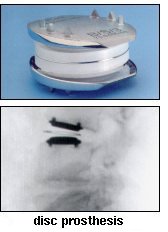| Total Disc Replacement Surgery |  |
| I
had this surgery at the Alpha Klinik in Munich, Germany on 14 November
2003. Dr. Willem S. Zeegers was my surgeon and will forever be my hero. Background information - How I got to the point where I needed surgery and why I decided to go to Germany to have this particular procedure. Post Operative X-rays - See the Bionic Dan's new back! |
When is a disc prosthesis suitable?
A
disc prosthesis is suitable for patients who are not older than 65,
when one lumbar disc is severely degenerated. A prosthesis is also
suitable for patients with ongoing back problems following an open disc
operation. A discography is usually done in advance to determine which
disc is causing the pain.
 What does the disc prosthesis procedure involve?
What does the disc prosthesis procedure involve?
The
degenerated disc is replaced and at the same time the normal distance
between the two vertebrae is restored. A mobile polyethylene disc is
supported on both sides by stainless steel plates. During the
procedure, which is performed from the front, the prosthesis is firmly
inserted resulting in immediate stability. The prosthesis allows normal
motion between the vertebrae. Thus, the adjacent discs are not
over-stressed as they are after a fusion operation. Note: Dr. Willem S.
Zeegers joined the Alpha Klinik - Munich in August 2000 and is a disc
prosthesis specialist with over ten years of experience in implanting
artificial discs in the Netherlands.
What post-op care and rehabilitation is required?
Two
hours after the procedure, the patient can walk to his room. In the
majority of cases, there is only minor post-operative pain. Most
patients can be discharged three to five days after the operation. The
patient is then allowed to sit, walk, drive a car or ride a bike. Six
weeks after the procedure there are no more restrictions on physical
activities.
Is this an experimental procedure?
As as with all surgical procedures, this was
an experimental procedure in its beginning, but the Link-Charite disc
prosthesis (see picture) has been in use for 15 years now. However,
only a few spine surgeons have learned the precise technique of this
operation. These surgeons experience very few serious complications. In
fact, the complication rate in the hands of these very experienced
surgeons is less than for a regular fusion operation. In follow-up
studies over the last ten years, no signs of wear have been determined
and the incidence of loosening is very rare.
Can complications occur?
Very
rarely, complications such as vascular problems may occur: However,
there is always a vasco-surgeon on standby to control eventual
bleeding. The infection rate is very low. Regarding thrombosis, after
their post-op check, the patient receives anti-coagulative protection
for two weeks, and before discharge an ultrasound check is performed to
rule out a possible thrombosis.
3D Animation of a Total Disc Replacement
This
animation shows in detail the procedure of implanting a disc prosthesis
and the animations are accompanied by text descriptions. The goal of
the disc prosthesis is to relieve pain caused by problems and pinched
nerves in the lower spine. The diseased disc is replaced by special
metal and polyethylene implants.
